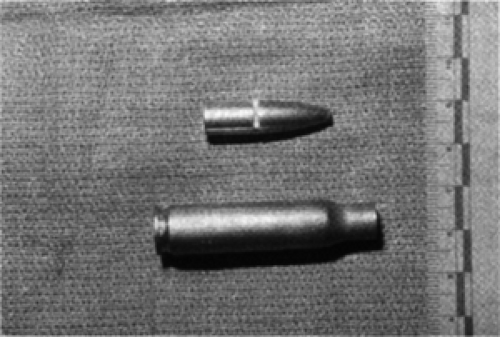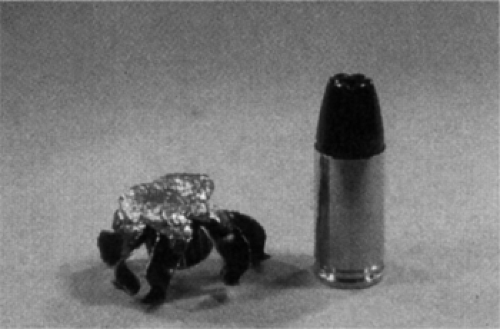Forensic Emergency Medicine: Penetrating Trauma
William S. Smock
Forensic emergency medicine is the application of forensic medical knowledge and appropriate techniques to living patients in the emergency department. Patients with penetrating trauma will seek care in the emergency department; they are usually not victims of happenstance or accident, but of malice and intent at the hands of assailants. This phenomenon reflects a major change in our society’s interactional dynamics. Given this new reality of our patient population, physicians must practice medicine—trauma medicine, in particular—in a new way, with attention to details heretofore overlooked. What was once considered confounding clutter that gets in the way of patient care (such as clothing and surface dirt) takes on a whole new significance when recognized for what it really is—evidence.
Traditionally, emergency physicians and nurses have been trained in the provision of emergency medical care without regard for forensic issues. In the process of providing patient care, critical evidence can be lost, discarded, or inadvertently washed away (1,2,3,4,5,6,7,8,9,10,11,12). Victims then lose access to information that can be of critical significance when criminal or civil proceedings arise secondary to their injuries (13,14).
Acknowledging the Void
The earliest references in the US medical literature to the practice of forensic medicine on living patients in our country decry its absence (1,15). These articles were written by two forensic pathologists and pioneers in clinical forensic medicine, John Smialek, MD, and William Eckert, MD. In 1986, Cyril Wecht, MD, JD, former president of the American College of Legal Medicine, stated
It’s a great shame and a source of much puzzlement why a group similar to police surgeons hasn’t developed here. Even within our adversarial judicial system and with our guaranteed civil rights—which are much greater than in many of the countries where forensic clinicians are commonly found—I believe those persons with both medical and forensic training could remove much of the guesswork, speculation, and hypotheses from the disposition of accident or assault cases involving living persons (10).
Filling the Void
The first postgraduate training program for emergency physicians dealing with clinical forensic medicine was a 2-day seminar in Chicago in 1990, sponsored by the Illinois chapter of the American College of Emergency Physicians. This program was suspended after its first year. An annual postgraduate clinical forensic medicine training seminar was subsequently established in Louisville in 1994 by the Kentucky chapter of the American College of Emergency Physicians. This program continued through 1998.
The Department of Emergency Medicine at the University of Louisville School of Medicine and the Kentucky Medical Examiner’s Office established the first formal clinical forensic medicine training program for residents in the United States in 1991 (3,4,9,11,16). Two years later, the first fellowship in clinical forensic medicine was created, also in Louisville. Concomitantly, the first formal clinical forensic medicine consultation service in the United States was established (3,4,9,11). In 1996, Dr. David Wells, in cooperation with the Australian College of Emergency Medicine and the Victorian Institute for Forensic Medicine, established a 6-month fellowship in clinical forensic medicine for emergency physicians (17).
Utility of Forensic Emergency Medicine
Emergency physicians and nurses, by design and default, evaluate and treat people with gunshot and stab wounds and victims of physical assault, sexual abuse and assault, domestic violence, and motor vehicle crashes. All of these patients have injuries or conditions that have criminal or civil forensic medical implications and the prospect or specter of courtroom sequelae (2). A patient’s emergency medical evaluation must be detailed and the documentation comprehensive. Comprehensive documentation ideally contains three components: narrative, diagrammatic, and photographic. The failure to document clinical findings comprehensively may have far-ranging consequences for a patient, an accused suspect, and, potentially, the treating physician (1,2,5,6,8,9,11,12,13,14,17,18,19,20,21). In a review of 100 charts of patients who presented to a level I trauma center in California, Carmona and Prince reported poor, improper, or inadequate documentation in 70% of cases (2). In 38% of these cases, potential evidence was improperly secured, improperly documented, or inadvertently discarded (2).
The forensically untrained emergency physician or nurse may easily overlook and inadvertently destroy evidence, both gross and trace, in the course of providing patient care. The emergency care provider may misinterpret physical injuries and evidence, and form an inaccurate opinion as to their cause (1,2,3,4,5,6,7,8,10,11,12,13,14,17,18,19,20,21). Such opinions, when recorded in the patient’s emergency department chart, may pose a considerable problem for the patient, the court, and the emergency physician if circumstances progress to legal proceedings.
If forensically untrained physicians and nurses can make mistakes that may haunt them and others in court, forensically trained physicians and nurses may be able to preclude the courtroom consequence entirely. One example of such avoidance is seen in a case involving a 20-year-old man who presented to a level I trauma center with a perforating gunshot wound to the left shoulder (4,11). The patient stated that he had been shot from a distance of 30 ft and that he knew the assailant’s name. When the police arrived in the emergency department, the patient requested that the assailant be arrested immediately, as he felt his life was in danger. Examination of the wound revealed soot surrounding the larger anterior wound, as well as soot on the patient’s shirt (Fig. 4-1). The examining emergency physician was aware that the presence of soot was indicative of a close range of fire and that the physical evidence did not support the history given. When the patient was confronted with this information, he recanted his story and admitted the wounds were self-inflicted in an attempt to “set up” the accused (4,11). The ability of the emergency physician to determine that the wound was consistent with having been inflicted at a close range prevented the accused from being arrested for a crime he did not commit. Traditionally, such wounds have been cleaned and debrided, removing all evidence in the process, including evidence that would distinguish entrance from exit and range of fire.
Forensic Aspects of Gunshot Wound Management
Emergency nurses and physicians treat more than 250,000 victims of gunshot wounds annually. Because they evaluate gunshot wounds before therapeutic or surgical intervention obscure the wound’s appearance, they are in an ideal position to evaluate and document the injuries. Documentation
of gunshot wounds in the medical record by the treating physician and nurse should include the number, location, size, shape, and characteristics of the wound(s). A precise description of a gunshot wound requires a basic understanding of wound ballistics and a familiarity with relevant forensic terminology (11).
of gunshot wounds in the medical record by the treating physician and nurse should include the number, location, size, shape, and characteristics of the wound(s). A precise description of a gunshot wound requires a basic understanding of wound ballistics and a familiarity with relevant forensic terminology (11).
Wound Ballistics
Wound ballistics is the study of the effect(s) of penetrating projectiles on the body (18,19,20,21,22,23,24,25). Several factors determine a bullet’s potential for wounding (22,23,24,25,26,27,28,29,30): the bullet’s velocity and weight, deformations/fragmentation upon impact with tissue, and the characteristics and location of the impacted tissue itself (22,23,26,27,31,32). The mechanism by which a bullet wounds is the transference of its kinetic energy to the relatively stationary tissue it hits. The severity of the wound inflicted is directly related to the amount of kinetic energy transferred to the tissue, rather than the total amount of kinetic energy possessed by the bullet itself (23,24,25,26,27). Bullets traveling at higher velocities have more kinetic energy and theoretically higher wounding potential; however, the physician should not assume that injuries associated with high-velocity projectiles from rifles will necessarily be more severe than those associated with low-velocity projectiles (Fig. 4-2). Wound severity is dictated by the interplay of several variables, not the bullet’s velocity alone.
Crushing is the principal mechanism by which bullets from handguns impart damage to tissue. A bullet traveling through tissue generates two cavities. The first is a temporary one, lasting only 5 to 10 ms from its generation until its collapse. The second is the permanent one, the crushed tissue we observe. The size of the cavity remaining (i.e., the wound) varies with the size, shape, and configuration of the bullet. A hollow-point bullet that mushrooms upon impact can increase its diameter by as much as 2.5-fold (Fig. 4-3). The hollow-point bullet’s capacity to change its shape increases the area of tissue crush it generates by 6.25 times that of a nondeformed bullet of a similar caliber (27).
 Fig. 4.2 A .308 caliber high-velocity rifle round. By virtue of their speed, high-velocity rounds have the potential to transfer large amounts of energy to body tissue. |
Forensic Terminology Associated with Gunshot Wounds
Most misinterpretations of gunshot wounds made by nurses and physicians involve the distinction between entrance and exit wounds. The errors are invariably based on the fallacious assumption that an exit wound will be larger than its corresponding entrance wound. The first study to compare the interpretations of emergency physicians, trauma surgeons, and neurosurgeons at a level I trauma center with those of a forensic pathologist determined that fatal gunshot wounds were interpreted correctly by the clinical practitioners in only 47.8% of cases (18).
Stay updated, free articles. Join our Telegram channel

Full access? Get Clinical Tree








